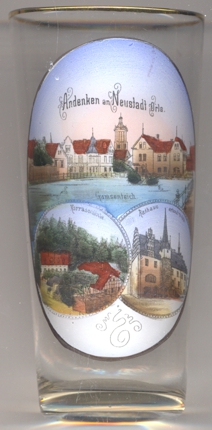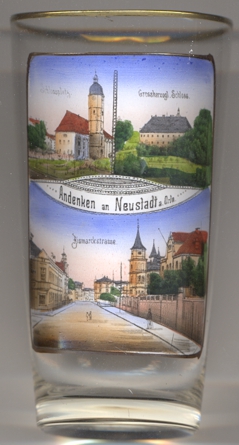

|
| DEUTSCHLAND | GERMANY |
| Bundesland: Freistaat Thüringen | Thuringia |
| Landkreis: Saale-Orla-Kreis |
 Neustadt an der Orla is situated at an elevation of 300 m on the river Orla in southeastern Thuringia.
The municipality has a population of about 8,200 (2014).
Neustadt an der Orla is situated at an elevation of 300 m on the river Orla in southeastern Thuringia.
The municipality has a population of about 8,200 (2014).
Arnshaugk castle, today in Neustadt, was founded around 1000. A settlement called Nova villa was mentioned in a document dating from 1120. Neustadt was founded as a town by the lords of Lobdeburg between 1150 and 1250; in 1287 the name was mentioned for the first time in a written document. The district Neustadt was formed as an administrative unit in the Ernestine Wettin countries. In 1567, the sovereignty passed to the Albertine line, and by 1660 the district Neustadt with its four subdistricts Arnshaugk, Ziegenrück, Weida and Mildenfurth formed a regular part of the Albertine Electorate of Saxony. From 1657 until 1718, Neustadt was part of the duchy of Saxe-Zeitz, a secundogeniture of Saxony. After the Congress of Vienna in 1815, Neustadt became part of the Ernestine grand duchy of Saxe-Weimar-Eisenach. In 1952, Neustadt became part of the district Pößneck (formed from parts of the former districts Gera, Saalfeld and Ziegenrück. Since 1994, Neustadt is part of the Saale-Orla district.
The  Stadtkirche Sankt Johannis [left, no. 3017: top picture: background centre] was created between
1470 and 1538 in place of an older chapel that already existed in the 13th century. Extensive redesigns were carried out in 1686 and 1769, followed
by restorations in the neo-Gothic style in 1893/1894. During the restoration of 1981–1983, remains of late Gothic wall paintings in the choir vault were
uncovered and restored according to the requirements of listed buildings. The historic organ from the 18th century was reconstructed in 1993.
Stadtkirche Sankt Johannis [left, no. 3017: top picture: background centre] was created between
1470 and 1538 in place of an older chapel that already existed in the 13th century. Extensive redesigns were carried out in 1686 and 1769, followed
by restorations in the neo-Gothic style in 1893/1894. During the restoration of 1981–1983, remains of late Gothic wall paintings in the choir vault were
uncovered and restored according to the requirements of listed buildings. The historic organ from the 18th century was reconstructed in 1993.
The  Town Hall [bottom right inset]
dates from the late Gothis period. It was created in 1464 by combining two older buildings, the previous town hall
and the former town hall chapel.
Town Hall [bottom right inset]
dates from the late Gothis period. It was created in 1464 by combining two older buildings, the previous town hall
and the former town hall chapel.
The  Harrasmühle [bottom left inset] was a former mill with several farm
buidings. Since 1893, the manor house was used as a restaurant. Betwee 1943 and 1945 the complex was used by
the nuclear physics research group of the Kaiser-Wilhelm-Institut Berlin-Dahlem.
Harrasmühle [bottom left inset] was a former mill with several farm
buidings. Since 1893, the manor house was used as a restaurant. Betwee 1943 and 1945 the complex was used by
the nuclear physics research group of the Kaiser-Wilhelm-Institut Berlin-Dahlem.
 The
The  Klosterkirche (Monastery Church) [near left, no. 4071: top left picture], also known as
Castle Church, is the only remaining part of the former Augustinian hermit monastery that was destroyed in the Thirty Years' War (1618–1648)
and emerged from its monastery church. The gate passage separating the nave was created in 1674 with the construction of a castle for the Dukes of
Saxony-Zeitz in the southern part of the site.
Klosterkirche (Monastery Church) [near left, no. 4071: top left picture], also known as
Castle Church, is the only remaining part of the former Augustinian hermit monastery that was destroyed in the Thirty Years' War (1618–1648)
and emerged from its monastery church. The gate passage separating the nave was created in 1674 with the construction of a castle for the Dukes of
Saxony-Zeitz in the southern part of the site.
 Neustadt castle [near left, no. 4071: top right picture] was built in 1674 in Baroque style
for Duke Moritz of Saxe-Zeitz. After his death in 1681, his fourth son, Duke Friedrich Heinrich, moved his residence from Pegau
to Neustadt and further enlarged the castle. When Neustadt in 1815 became part of the Grand Duchy Saxe-Weimar-Eisenach,
the castle was again remodeled for the Grand-ducal family. After 1945 the castle was used as a vocational school, and later on as a retirement home.
Since 2008 a private school uses the building.
Neustadt castle [near left, no. 4071: top right picture] was built in 1674 in Baroque style
for Duke Moritz of Saxe-Zeitz. After his death in 1681, his fourth son, Duke Friedrich Heinrich, moved his residence from Pegau
to Neustadt and further enlarged the castle. When Neustadt in 1815 became part of the Grand Duchy Saxe-Weimar-Eisenach,
the castle was again remodeled for the Grand-ducal family. After 1945 the castle was used as a vocational school, and later on as a retirement home.
Since 2008 a private school uses the building.
The bottom picture on glass no. 4071 [near left] is labeled  Bismarckstraße.
Bismarckstraße.
Further places called Neustadt (or similar), of which glasses are in this collection, are:
[https://de.wikipedia.org/wiki/Neustadt_an_der_Orla;
https://de.wikipedia.org/wiki/Stadtkirche_St._Johannis_(Neustadt_an_der_Orla);
https://de.wikipedia.org/wiki/Rathaus_(Neustadt_an_der_Orla);
http://www.heimatfreunde-neustadt-orla.de/neustadt-umgebung/item/009-erinnerung-an-die-gesandten-zum-20ten.html;
https://de.wikipedia.org/wiki/Schloss_Neustadt;
https://www.wohnringag.de/files/147E7BF47C9/Mieterzeitung-Nr.23-Juli-2014.pdf]
in Austria:
in the Czech Republic:
in Germany:
in Hungary:
in Poland:
in Romania:
![[scale]](lineal.jpg)